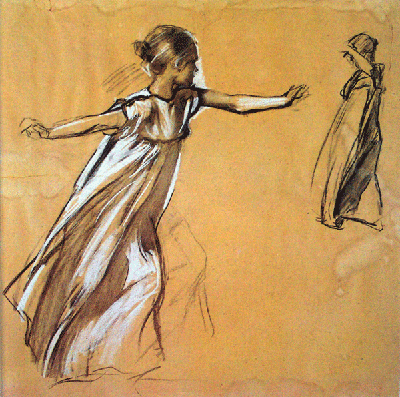The significance of skills as a draughtsman were considered essential to being recognised as a respectable painter during the Italian Renaissance, but Spain placed less of a focus on this medium. That said, Velazquez was taught by his father of the importance of developing sketching skills before taking on painted portraits.
Joaquin Sorolla was a talented draughtsman, but it has proven tricky to locate many of his original drawings. Most were intended purely as study pieces and not given the protection that they deserved. Some have survived to the present day, and these tend to remind us of the figurative drawings of Edgar Degas. The entire genre of portraiture, particularly full length ones, can only be tackled effectively through artists willing to hone their craft in sketchbooks over a number of years. We can see examples of this ever since the early Renaissance, though in that period they tended to work on individual leaves of paper and fill each and every spare part of it with different sketches of limbs, poses and in some cases written notes. It was later on that sketchbooks became more frequent, such as with the work of Turner in the Romanticist era. He was actually more interested in capturing landcape scenes from the outdoors, and could use this process more easily than carrying painting equipment around various picturesque parts of mainland Europe.
Of the Sorolla drawings that still remain from his career, and that have also been successfully attributed to the artist, we can summise that most were produced using any of pencil, ink and charcoal. There is a huge variance in how 'finished' these drawings were, with many intended as simple explorations of a simple element of an overall composition. In other cases, though, he would create highly detailed depictions that gave us genuine artworks which could work on their own. His Study of Hands, for example, comes from circa 1889 amd goes into the finest detail. It will remind many of a famous artwork from the Northern Renaissance, namely Praying Hands by Albrecht Durer. There is a similarity in precision and quality, even though Sorolla himself is only really famous now as a painter. The work by Sorolla was part of a series of drawings purchased by the Meadows Museum, SMU, Dallas as recently as 2018. It indicates that the artist is still much in demand and also that his reputation does persist outside of his native Spain, even if it is to a lesser extent.
This purchase made a lot of sense as the Meadows Museum already owned several original items from this artist's career, and wished to strengthen their representation of his work. Much of it was purchased directly from the artist's descendants who appear willing to sell some of his work on occasion, to suitable buyers who wish to represent the artist in the right way. Many of these sketches provided outlines of figures, as Sorolla attempted to plan his painted compositions. He would often just leave rough outlines of figures, concerned more about how they lined up together. Some were pencil sketches of portraits of whole families, whilst others depicted working men with their cattle in the fields. These themes would all then appear later on in his painted pieces, and it was then that the incredible light and colours would appear. The Museum which purchased these items has the desire of allowing its students to get a broader understanding of this artist's working practises, across a variety of different mediums and genres.
These early drawings have also proven useful to a number of amateur artists around the world who have a desire to paint in a similar way to how Sorolla worked over a century ago. We can understand everything about his processes visually, which allows for artists all over the world who may not speak the same verbal languages. One can also compare these with other artists to notice any variations in order to understand how Sorolla was unique, and how he also followed established artistic practises. There a number of enthusiasts who have studied his paintings in great detail in order to understand which techniques he used, but it is important to also appreciate what work he did before starting with oils. These earlier preparations involved laying out a piece and were particularly important in his more complex arrangements, such as where there were a number of different figures in a variety of poses and at different angles.




